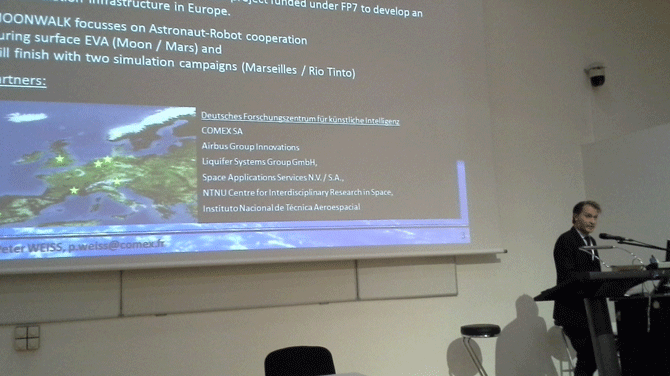THE MOONWALK PROJECT ASTRONAUT-ROBOT COOPERATION IN EUROPEAN SPACE ANALOGUE SIMULATIONS
ASTech International Conference Space Exploration
THE MOONWALK PROJECT ASTRONAUT-ROBOT COOPERATION IN
EUROPEAN SPACE ANALOGUE SIMULATIONS
Dr. Peter WEISS [1], Dr Bernard GARDETTE[1], Dr. Virginie TAILLEBOT[1], Thibaud GOBERT[1][8], Dr. Thomas VÖGELE[2], Mathias HÖCKELMANN[2], Jakob SCHWENDNER[2], Alistair NOLTE[3], Matthew ROBERTS[3], Dr. Barbara IMHOF[4], Waltraud HOHENEDER[4], Stephen RANSOM[4], Robert DAVENPORT[4], René WACLAVICEK[4], Diego URBINA[5], Tom HOPPENBROUWERS[5], Dr. Knut Robert FOSSUM[6], Dr. Victor Parro GARCÍA[7], Dr. Olga PRIETO[7]
[1] COMEX SA, [2] Deutsches Forschungszentrum für künstliche Intelligenz, [3] Airbus Group Innovations [4] Liquifer Systems Group GmbH, [5] Space Applications Services N.V. / S.A., [6] NTNU Centre for Interdisciplinary Research in Space, [7] Instituto Nacional de Técnica Aeroespacial, [8] Laboratoire de mécanique et d’acoustique de Marseille Main author’s address: Peter WEISS, COMEX SA, 36 Bvd des Océans, 13009 Marseille, France, p.weiss@comex.fr
ABSTRACT
The MOONWALK project (http://www.projectmoonwalk.net/) is a three year cooperative R&D project funded by the European Commission under the FP7 programme. The goal of the project is to develop and test technologies and training procedures for astronaut-robot cooperation in earth-analogue environments as it applies to Extra-Vehicular Activities (EVA) on Moon and Mars.
Surface EVA will primarily include soil sampling and exobiology activities. Robots can help carrying material and equipment for the astronauts, assist in the installation of instruments, scout sites that are too dangerous for humans, or assist in search and rescue activities.
For MOONWALK, the underwater site at the Marseilles Space Analogue site will serve as a Moon mission analogue, while the Martian-like landscape of Rio Tinto in Spain will be the Mars mission analogue. Earth-analogues will enable the Moonwalk team to analyze, research and test operations and technologies as well as train future astronauts with limited cost and risk. However, current analogue sites do not sufficiently represent all the constraints that astronauts, their robotic assistants and equipment will face during real EVA on a lunar or Martian surface. The presentation will give an overview on the objectives and technology developments in MOONWALK and provide an outlook on simulation activities within the project.
Presentation at Conference


